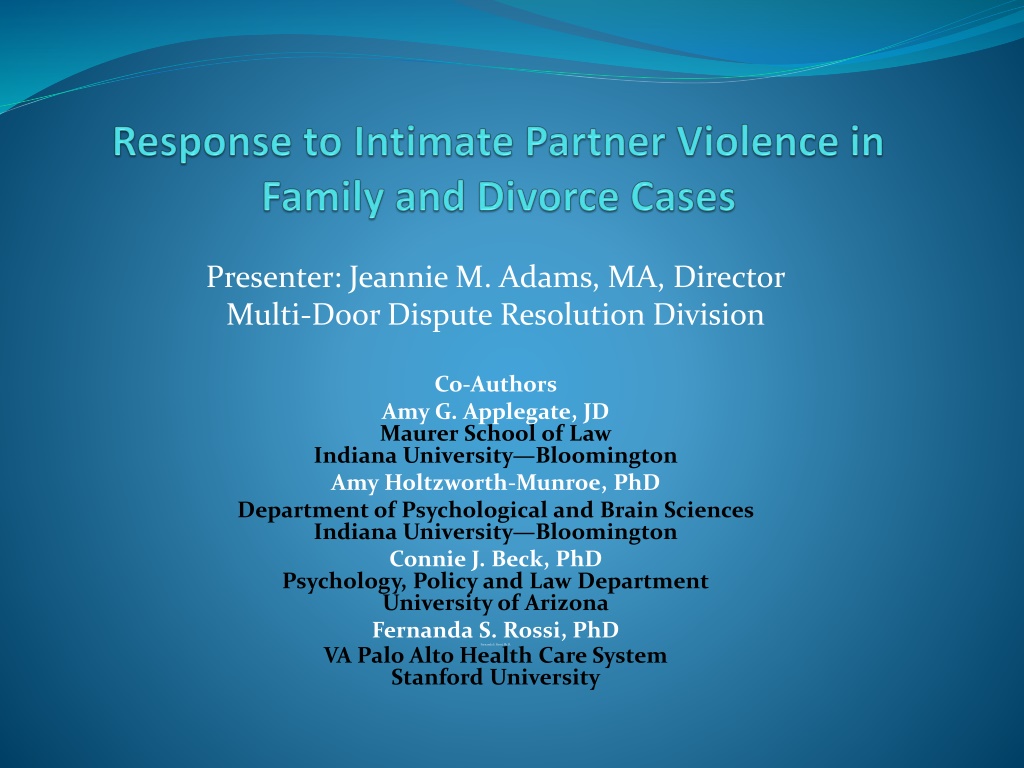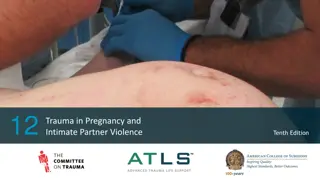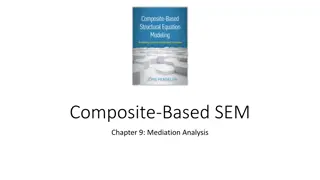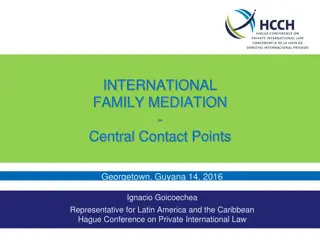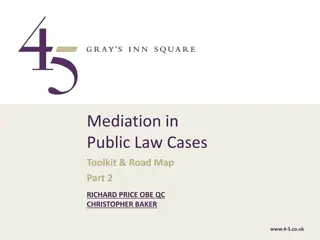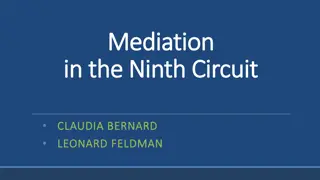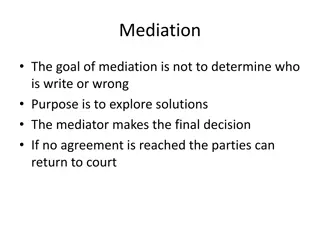Understanding Intimate Partner Violence (IPV) in Mediation
Exploring the safety and appropriateness of mediation in cases involving Intimate Partner Violence (IPV), this content discusses differing viewpoints on the matter, the screening process to detect IPV, definitions of IPV, and the importance of systemic IPV screening. It highlights the need for accommodations in mediation for cases with IPV, such as support persons, security measures, and physical separation of parties.
Download Presentation

Please find below an Image/Link to download the presentation.
The content on the website is provided AS IS for your information and personal use only. It may not be sold, licensed, or shared on other websites without obtaining consent from the author. Download presentation by click this link. If you encounter any issues during the download, it is possible that the publisher has removed the file from their server.
E N D
Presentation Transcript
Presenter: Jeannie M. Adams, MA, Director Multi-Door Dispute Resolution Division Co-Authors Amy G. Applegate, JD Maurer School of Law Indiana University Bloomington Amy Holtzworth-Munroe, PhD Department of Psychological and Brain Sciences Indiana University Bloomington Connie J. Beck, PhD Psychology, Policy and Law Department University of Arizona Fernanda S. Rossi, PhD Fernanda S. Rossi, Ph.D. VA Palo Alto Health Care System Stanford University
Is Mediation Safe and Appropriate for Cases with Intimate Partner Violence (IPV)? 2
Mediation assumes that parents are roughly equal in bargaining power and capable of negotiating Parents will bargain in good faith to reach agreements that are safe and in the best interests of children
Differing Views on Whether Mediation is Safe and Appropriate for Cases with IPV? Mediation is never appropriate for this population Mediation may be appropriate with accommodations, including: Support person or attorney Security measures Suspend or terminate mediation as necessary Parties kept physically separate, e.g., Shuttle mediation Telephone, on-line, or Video-conferencing mediation 4
Screening process, detecting IPV in family and divorce cases Mediation program staff administer IPV screening of all mediation parties Multi-Door Screening Process Mediator Assessment of Safety Issues and Concerns (MASIC) Mediator s Assessment of Safety Issues and Concerns Holtzworth- Munroe, Beck, & Applegate (2010) Family Court Review
Definition of Intimate Partner Violence (IPV) Multidimensional Construct Psychological/Emotional Abuse Coercive Controlling Behaviors Physical Aggression and Violence Sexual Assault, Intimidation & Coercion Stalking Fear
Systematic IPV screen led to more party reports of IPV Screening determines suitability for mediation: Study 1 findings, A behaviorally specific systematic screening instrument (MASIC) detected more IPV than A set of systematic screening questions (Multi-Door) that was not behaviorally specific
Multi Door Process for Screening for IPV Administered by trained staff Conducted in a safe and sensitive way Interview with parties separated Systematic (every case) Standardized measure and process Behaviorally Specific questions asked
Intimate Partner Violence (IPV) and Custody Decisions: A Randomized Controlled Trial of Outcomes from Family Court, Shuttle Mediation or Videoconferencing Mediation Key Personnel: Holtzworth-Munroe, Beck, Applegate, Hale, Adams, & Rossi Funded by: National Institute of Justice This project was supported by Award No. 2013-VA-CX-0044, awarded by the National Institute of Justice, Office of Justice Programs, U.S. Department of Justice. The opinions, findings, and conclusions or recommendations expressed in this publication/program/exhibition are those of the author(s) and do not necessarily reflect those of the Department of Justice. 9
Study 2. National Institute for Justice Grant funded Randomized Controlled Study Randomized Controlled Study Study groups Shuttle mediation Video conferencing mediation Back to court Voluntary participation Safety protocols in place Support from DV Community, Office of Violence Against Women and Battered Women s Justice Project
Intimate Partner Violence (IPV) and Mediation Concerns: Safety (victim and others) Power imbalance (victim vs abuser) Victim not able to exercise self-determination Proponent responses: Would victim fare better in court? Disempowerment of victim who wants to mediate Accommodations address concerns 11
Design to maximize safety Protocols for arrival and departure Security officers present Panic buttons in rooms Mediators and staff trained in IPV Findings cannot be applied to less safe environments or untrained mediators. Not suggesting mandated mediation or joint mediation for these cases.
Reported feeling safe during process, more satisfied and more positive feelings about various aspects of process, such as fairness, building rapport No significant differences in case outcome across conditions with regard to satisfaction with outcome or mediator.
Contact information Jeannie M. Adams, Director Multi-Door Dispute Resolution Division Email: jeannie.adams@dcsc.gov
